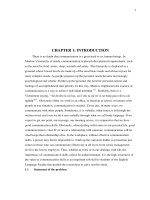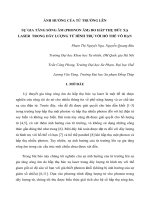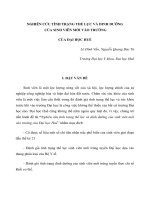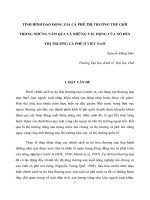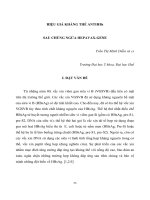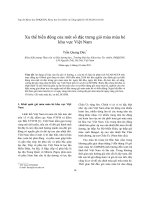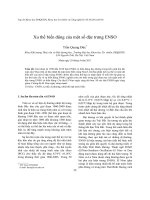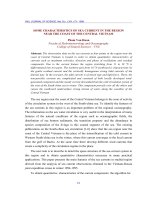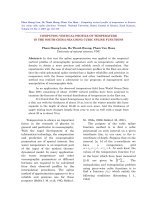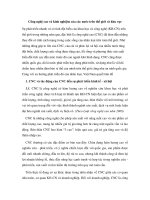Báo cáo nghiên cứu khoa học " Improving the safety and quality of Vietnamese vegetables through research and capacity building in quality assurance, postharvest management and high technology protected cropping systems - MS6 " pptx
Bạn đang xem bản rút gọn của tài liệu. Xem và tải ngay bản đầy đủ của tài liệu tại đây (96.37 KB, 11 trang )
Ministry of Agriculture & Rural Development
CARD Project Progress Report
004/04VIE: Improving the safety and quality of
Vietnamese vegetables through research and capacity
building in quality assurance, postharvest
management and high technology protected
cropping systems
MS6: THIRD SIX-MONTHLY REPORT
1
Institute Information
Project Name
Improving the safety and quality of Vietnamese
vegetables through research and capacity building in
quality assurance, postharvest management and high
technology protected cropping systems.
Vietnamese Institution
Research Institute of Fruits and Vegetables (RIFAV)
Trau Quy, Gia Lam, HANOI
Vietnamese Project Team Leader
Associate Prof. Dr. Tran Khac Thi
Australian Organisation
NSW Department of Primary Industries
Gosford Horticultural Institute
Centre of Excellence in Market Access and Greenhouse
Horticulture
Incorporating the National Centre for Greenhouse
Horticulture
Australian Personnel
Dr Suzie Newman; Dr Sophie Parks
Mr Joseph Ekman; Dr Vong Nguyen
Date commenced
30th September 2005
Completion date (original)
30th September 2007
Completion date (revised)
30th November 2007 (to take into account delay in
signing of contracts)
3rd Six monthly report
Reporting period
Contact Officer(s)
In Australia: Team Leader
Name:
Position:
Organisation
Dr Suzie Newman
Research Horticulturist
NSW Department of
Primary Industries
Telephone:
Fax:
Email:
+61 2 4348 1934
+61 2 4348 1910
In Australia: Administrative contact
Name:
Position:
Organisation
Graham
Denney
Administrative officer
NSW Department of
Primary Industries
Telephone:
Fax:
Email:
In Vietnam
Name:
Position:
Associate Prof Dr Tran Khac Thi
Deputy Director
Telephone:
Fax:
Organisation
Research Institute of Fruits and
Vegetables (RIFAV), Trau Quy, Gia
Lam, HANOI
Email:
84-4-8276316
84-4-8276148
;
2
1. Project Abstract
Chemical residues left by fungicides and insecticides are among the major problems causing
contamination of vegetables in Vietnam. The development of safe food production methods was
fostered by the previous NSW Department of Primary Industries project (CARD-0016; 2001-2003)
but this can only be realised with further research and development. This project addresses the issues
of food safety and food quality from production to market to encourage the economic viability and
sustainability of the Vietnamese vegetable industry. This project seeks to: 1) Facilitate the wider
implementation and adoption of protected cropping systems of low to medium technology that require
fewer chemical inputs through targeted research and extension activities 2) Examine current supply
chain constraints and utilise quality assurance principles to implement targeted system improvements
and 3) Enhance Vietnamese research, development and extension capacity in the areas of protected
cropping systems, postharvest management and quality assurance systems. This project has continued
to address these objectives through: 1) research demonstration trials in Hanoi, Lam Dong and Hue to
identify the most suitable media and production system for greenhouse cucumber and tomato
production; 2) capacity building of Vietnamese project personnel through an intensive training period
in Australia during July 2006 and 3) research undertaken in Australia on the suitability of Vietnamese
cocopeat for greenhouse crop production.
2. Executive Summary
Protected cropping provides vegetable growers with an opportunity to enhance
product quality and improve food safety. The overall objective of this project is to
provide Vietnamese scientists and extension specialists with the training and tools to
implement and foster regionally feasible improvements to current vegetable
production practices and supply chains. The project is led by the Research Institute of
Fruit and Vegetables with Hue University of Agriculture and Forestry and the
Institute of Agricultural Sciences for South Vietnam as the Vietnamese project
partners. NSW Department of Primary Industries is the Australian partner.
Key achievements during this 3rd six monthly period include:
• The successful completion of a training course on protected cropping systems,
postharvest and quality assurance by 3 project staff - Mrs Nguyen Thi An
(FAVRI, formerly RIFAV), Mr Ngo Minh Dung (IAS) and Mr Nguyen Dinh
Thi (HUAF). Their training comprised lectures, field work and laboratory
based training. They also visited farms, research stations, markets and
exporters to gain an understanding of current practices in Australia with a
view to looking at how what they learned in Australia could be adapted to
agricultural practice in Vietnam. To assist them with this they were
accompanied by Mr Nguyen Hong Phong a farmer and major vegetable seedling
producer from Duc Trong in Lam Dong Province. Mr Phong’s assisted the team
in looking at how technology or crop management techniques may be adapted
and applied to Vietnam.
• Preparations for the development of two training workshops in Dalat and Can
Tho are well underway. The program includes presentations from Vietnamese
and Australian project partners on protected cropping, postharvest and Good
Agricultural Practice (GAP). The workshops will take place 27-28 April and
3-4 May. It is intended that these workshops will have greater participation of
farmers and other supply chain participants and that there will be additional
informal training activities either side of the workshop.
3
•
•
The successful continuation of research demonstration trials in Hanoi, Hue and
Lam Dong Province investigating the effect of different growing media on
plant growth and development for tomato and cucumber.
The continuation of research at Gosford Horticultural Institute examining the
chemical and physical properties of Vietnamese cocopeat and determining the
water usage of different media (including coir) for greenhouse cucumber and
ornamental production.
3. Introduction & Background
Protected cropping systems provide vegetable farmers with the opportunity to produce
high yielding, good quality crops with reduced pesticide inputs. Our previous
AusAID-CARD project (0016) focussed on development of a low-tech greenhouse
system to enhance the productivity and sustainability of the Vietnamese vegetable
industry. The nethouse with run-to-waste cocopeat system was shown to be an
effective and cost effective model, however further optimisation and extension of this
technology is required to facilitate successful adoption. This project focuses on
providing the tools for optimising vegetable production in low-medium technology
greenhouses and delivering high quality product to market. This will be achieved
through formal and informal training initiatives including in-country workshops,
intensive Australian based training programs for research and extension staff and a
series of research demonstration trials. This project uses a participatory research approach
to foster uptake by both Vietnamese institutions and key stakeholders (farmers, extension
agents, supply chain partners).
The objectives of this project are to:
1. Facilitate the wider implementation and adoption of protected cropping
systems of low to medium technology (greenhouses/nethouses) that require
fewer chemical inputs through targeted research and extension activities;
2. Examine current supply chain constraints and utilise quality assurance
principles to implement targeted system improvements;
3. Enhance Vietnamese R&D capacity in the areas of protected cropping
systems, postharvest management and quality assurance systems.
4. Fostering links between growers, wholesalers, traders and researchers to
increase the productivity and competitiveness of Vietnamese smallholder
agriculture and related rural enterprises
4. Progress to Date
4.1
Implementation Highlights
Change of Project Leader
In September 2007, Dr Suzie Newman replaced Dr Vong Nguyen as Australian
project leader, following Dr Nguyen’s retirement. Dr Nguyen will continue to remain
involved in the project in a voluntary capacity and so his expertise and experience will
not be lost from the project team. This will include a prominent role during the
second round of project workshops to be held in Dalat and Can Tho in April/May
2007.
4
Visit by Australian Project Leader, October 2006
Dr Suzie Newman visited Ho Chi Minh and Dalat in October 2006 to undertake a
supply chain case study and to discuss opportunities for collaboration with Metro. Dr
Newman spent from the 1st-5th October in Vietnam, following on from travel
undertaken for an ACIAR project in Cambodia. During this time she travelled to Lam
Dong Province to interview Mr Phong (tomato seedling producer) regarding his
nursery and growing operations. Whilst there she also took the opportunity to visit
the Metro collection point and discuss their operations in Dalat. What emerged from
this discussion and later discussions with Metro management staff (Stephane Maulin,
Division Manager, Fresh Food; Thai Hong Xuan Nguyet, Supply Chain Manager and
Le Thi Minh Trang, Quality Assurance Manager) was that Metro is still having
difficulty sourcing sufficient quantities of product that meets their quality
specifications. They are also still in the process of implementing best practice in their
supply chains and all staff were realistic that it would take a considerable amount of
time to achieve their quality and supply goals. Metro staff expressed an interest in
working with the project team to improve quality outturn. They were keen to link in
with any postharvest/quality assurance training that we would be undertaking and to
work with groups of farmers. Opportunities for developing future links will be
explored in 2007.
Intensive training for 3 Vietnamese scientists in Australia
In July 2006, 3 Vietnamese scientists
• Mrs Nguyen Thi An (FAVRI, formerly RIFAV)
• Mr Ngo Minh Dung (IAS)
• Mr Nguyen Dinh Thi (HUAF)
undertook a 4 week training course in Australia. The course program is included in
Appendix 1. A copy of the travel report can also be obtained from Dr Newman or
Assoc Prof Dr Thi. Training focused on both field and greenhouse vegetable
production, postharvest and supply chain management and implementing Good
Agricultural Practice (GAP). Field visits to low tech (Sydney Basin) and high tech
(Yanco, Gosford) greenhouses and farms also encouraged training participants to
consider how they could adapt such technology to Vietnamese conditions. In addition
to visiting numerous farms, training participants also visited Sydney Wholesale
Markets, and an importing and export business to enable them to understand
Australian supply chains and quality requirements. Visits to research stations at
Gosford and Yanco provided the visitors with an insight into the types of research and
extension projects undertaken by NSW DPI and how R&D programs are managed in
Australia. Throughout their visit they were accompanied by Mr Nguyen Hong Phong a
farmer and major vegetable seedling producer from Duc Trong in Lam Dong Province. Mr
Phong’s assisted the team in looking at how technology or crop management
techniques may be adapted and applied to Vietnam.
Preparing training workshops in Dalat and Can Tho
Preparations are well underway for two workshops to be held in Can Tho (27-28
April) and Dalat (3-4 May). The workshops will be similar in format to last years
workshops held in Hanoi and Ho Chi Minh. However this year we hope to have 50%
of participants being farmers or other supply chain participants. We have also moved
one of the workshops from Hue to Dalat as recommended by one of the reviewers of
our last milestone report. However we hope to hold some informal training courses in
5
Hue to assist farmers in this region who are not able to attend the workshop in Dalat.
This may be take the form of a field day.
Vietnam Research Demonstration Trials
Research demonstration trials have been undertaken in Hanoi, Lam Dong province
and Hue utilizing Vietnamese cocopeat based media. The trials have focused on
variety evaluation and the implementation of drip irrigation. A full report
documenting trial results will be prepared as part of the July milestone. During the
Australian teams visit in April/May, time has been set aside to go through all the trial
results with our Vietnamese partners and discuss publication preparation.
Hanoi
A trial was carried out at the Research Institute of Fruit and Vegetables (RIFAV),
comparing the productivity of 8 cucumber varieties (Q9, Q16, Q19, Tohoku, Khassib,
Status III, Deena and Ajax) grown in a Vietnamese cocopeat media. The design was
a randomized block design with 4 replicates.
The trials were sown in September and harvested from October to November, 2006.
Fruit size ranged from 117-126g for standard varieties and 5.9g for the cocktail
variety. Marketable yield ranged from 14 t/ha for Khassib to 56 t/ha for Deena, whilst
the cocktail variety yielded 3.2 t/ha Levels of fruit set varied significantly between
varieties ranging from 15-47% and considerably between replicates. The best
performing variety was Deena, producing high yields of well sized fruit.
Hue
Tomato and cucumber trials were carried out in a specifically constructed net house at
HUAF. The cucumber trial compared the productivity of 5 cucumber varieties (Chua
Young Sheng, Status Natu 3, Tohoku, Khassib and Deena) using a Vietnamese
cocopeat mix. In this trial the most productive variety was Tuhoku with the highest
marketable yield of 49 t/ha. This variety also produced large sized fruit 274g and had
lower levels of pest and disease damage.
The tomato trial examined the suitability of using drip irrigation with a cocopeat
media for off-season tomato production in a net house. The trial compared a planting
layout of 1 plant/bag with one dripper (standard practice) with 2 plants/bag (2
drippers). The trial was conducted from August-November 2006. Whilst there was
little difference in total yield between the two systems, marketable yield was
substantially higher in the 1 plant/bag treatment (58% compared with 42% for 2
plant/bag treatment). Pest and disease damage was also lower in this treatment.
Four winter/spring trials are also underway and will be reported on in the July
milestone.
Cocopeat Research (Dr Sophie Parks and Dr Ross Worrall)
Greenhouse media water usage
A trial has also been established at GHI to compare the water usage of different media
(including coir) for cucumber and flannel flower production.
6
Two species that differ in water requirements were chosen. These include cucumber
having a high water requirement and an ornamental, flannel flower, as the low water
requiring comparison.
A low technology system is being used to determine the daily water use of plants
growing in a greenhouse. Water wicks up into the substrate from the base of the pot
fed by an individual tank. As the plant uses water the level in the tank drops and can
be measured. Pots without plants have been included to allow estimation of the
evapotranspiration of units.
Two substrate mix types, one including coir will be compared.
Mix 1: 25% sand 25% perlite 25% pine bark 25% coir
Mix 2: 25% sand 25% perlite 50% pine bark
The inclusion of coir is expected to increase the wicking ability of mix 1. The effect
of the two mixes on plant growth and water use will be determined.
Measurements:
• Physical and chemical characteristics of mixes before and after the experiment
• Daily water use
• Leaf area (at weeks 3,6,9 & 12)
• Flannel flower number
• Cucumber fruit number/weight
• Plant dry weight
• Daily solar radiation and temperature will be monitored using sensors and
related to water use (providing a predictive model).
The autopot experiment for cucumber grown in two substrate types was successful in
the collection of data on production and water use over the course of the crop. The
autopot system, a subirrigation system with independent tanks for each cucumber
plant, proved useful for this purpose. This was a simple measurement of the volume
required to refill the tank as water was used by the crop. However, the similar autopot
experiment for flannel flowers was not successful as their slow growth did not permit
accurate measurement of water over short periods.
The two mixes were not significantly different in terms of cucumber production
(shoot dry weight and total fruit fresh weight) or water use. Mix 1 consisted of 25%
sand 25% perlite 25% pine bark 25% coir. Mix 2 consisted of 25% sand 25% perlite
50% pine bark. The relationship between the total amount of water used over the crop
and shoot dry weight was linear, and was similar for both mixes (Fig. 1).
7
140
120
Shoot dry weight (g)
100
Mix 1
80
Mix 2
Linear (Mix 1)
60
Linear (Mix 2)
40
20
0
0
20000
40000
60000
80000 100000 120000
Total w ate r us e (m l)
Figure 1: Cucumber plant shoot dry weight associated with the total amount of water
used by the plant grown in either mix 1 or mix 2.
The amount of water used over time increased with plant growth and was similar for
plants grown in both mixes (Fig. 2).
120000
Total water used (ml)
100000
80000
Mix 1
Mix 2
60000
Poly. (Mix 1)
Poly. (Mix 2)
40000
20000
0
2-Jul
12-Jul 22-Jul 1-A ug
11A ug
21A ug
31A ug
10-Sep
Date of harve s t
Figure 2: Cucumber total water use over time in either mix 1 or mix 2.
Autopots are a useful and simple tool for measuring cucumber crop water use and
could be used by growers for monitoring water use on a daily basis. They could also
8
be effectively used for demonstration purposes in Vietnam to illustrate crop water use
to farmers, research and extension personnel. The two substrates that differed in their
components did not affect the water used or the growth performance of cucumber
plants.
4.2
Smallholder Benefits
The workshops in Dalat and Can Tho and the informal training opportunities provided
alongside these events will provide training opportunities for farmers and other supply
chain participants. Linkages with these farmers will be fostered throughout the life of
the project to facilitate rapid adoption of project outputs.
4.3
Capacity Building
Capacity building has been the focus of much of the project activities during the last
six months. Activities undertaken include: preparing for the in-country workshops in
Dalat and Can Tho and delivering the intensive training program for Vietnamese
scientists in Australia. As detailed earlier, the workshops delivered in-country in
April/May will cater for an increased number of farmers and other supply chain
participants and we hope that this enable more rapid uptake of project results.
4.4
Publicity
Several publicity items are planned for the next reporting period.
4.5
Project Management
In September 2007, there was a change in Australian team leader with Dr Vong
Nguyen retiring from NSW DPI. Dr Suzie Newman has replaced him as Australian
team leader, however Dr Nguyen will continue to be involved with the project and
participate in the workshops in Dalat and Can Tho. The transition in project
leadership has proceeded relatively smoothly.
The project remains on-track and there are no changes to project milestone dates to
report.
5. Report on Cross-Cutting Issues
5.1
Environment
Training project staff in Good Agricultural Practice (GAP) is one of the main
focuses of the training provided in this project. In July, Vietnamese project
staff undertook training on Quality Assurance systems and Good Agricultural
Practice (GAP). There visit was timely as FreshCare was at the time finalizing
their environmental module. Joseph Ekman (project team member and QA
extension officer) is one of the key developers of this module and so he was
able to present the latest information and developments to our Vietnamese
counterparts. They were then able to see QA systems in operation through their
9
visits to farms who had implemented FreshCare. Training participants were
encouraged to think through how such systems could be implemented in
Vietnam. With the release of ASEAN GAP guidelines, it is likely that Vietnam
will look to further develop a GAP system and trained extension specialists will
be required to develop and implement this system. At the present time the
Vietnamese vegetable industry falls short of the environmental requirements
under many GAP systems with use of non-composted farm manure,
unregistered chemicals and inadequate with-holding periods. Providing plant
protection officers and extension specialists with knowledge on GAP systems
and how they are implemented should assist Vietnam with the uptake of these
systems over the next few years.
5.2
Gender and Social Issues
This CARD project will continue to address gender and social issues as they
arise throughout the project.
6. Implementation & Sustainability Issues
6.1
Issues and Constraints
The structure of this project is such that a large number of project milestones and
payments have been placed in the last 8 months of the project. This is difficult for two
reasons:
• Limited travel (one trip) for Australian staff in the second year of the project
make it difficult to co-ordinate activities and ensure that the project remains
on-track.
• Budget management – having a large number of milestones and
corresponding payments in the second half of the project make budget
management difficult for NSW DPI with the Australian Institution having to
carry over large negative budgets to ensure the Vietnamese project partners
receive the funds they require for carrying out project activities.
The new Australian project manager (Dr Newman) believes that some of the project
performance indications are too ambitious given the short term nature (2 years) of the
project and the geographic spread of project partners. The project will achieve
significant project outcomes however given the project focuses mainly on capacity
building rather than direct intervention it is likely that the performance indicators will
take longer to achieve.
6.2
Options
During our visit in April/May we will visit each of our project collaborators to
ensure that the project remains on-track to meet its project milestones. Part of
this visit will include finalizing all the data from trials and preparing required
publications. However it is still envisaged that an additional trip will be
required and it is proposed that the project leader and the greenhouse specialist
return to Vietnam in September to finalise project activities. It is proposed to
try and use any potential savings from the Australian budget to fund this visit.
10
It is also recommended that more realistic performance indicators be
redeveloped for the project.
6.3
Sustainability
One of the focuses of the current set of trials is to compare field and
greenhouse/nethouse production. A number of the demonstration trials will take
place on farm, facilitating greater uptake of results by farmers. The comparison
of field and greenhouse production should clearly demonstrate whether or not
greenhouse production is economically viable in each region. Project
collaborators have been encouraged to hold field days wherever possible to
enable farmers to see first hand the results from the trials.
7. Next Critical Steps
The following activities will take place in the next six months:
• Workshops in Can Tho and Dalat
• Informal training of farmers in crop management and Good Agricultural
Practice
• Finalisation of trial results from each region and the preparation of
publications
• Developing of resource and extension materials on supply chain
management, GAP and greenhouse management.
• Continued research on cocopeat at GHI
8. Conclusion
Highlights from the last six months include:
•
A successful visit by research personnel from each of the partner
Vietnamese institutes for training on vegetable production, postharvest
and Good Agricultural Practice (GAP)
•
Continuation of the research demonstration trials in Hanoi, Lam Dong and
Hue looking at improved production systems of cucumber and tomato
•
Continuation of the research undertaken at GHI on characterising the
chemical and physical properties of Vietnamese cocopeat and its
suitability for crop production.
The project is currently on-track and so far there have been no major constraints
to project implementation.
11
